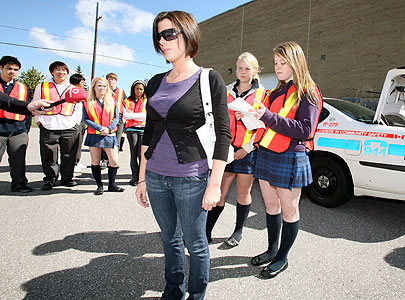Oshawa speed trap has a twist
Oshawa speed trap has a twist

YVONNE BERG FOR THE TORONTO STAR
A woman pulled over for speeding at Rossland Rd. W. and Stevenson Rd., May 15, 2008, is reminded by students Courtney Brazier and Felicia Petric, right, of the consequences of speeding.
May 16, 2008 04:30 Am
CAROLA VYHNAK
URBAN AFFAIRS REPORTER
Tearful driver Patty Ryan vowed to slow down as she hugged the young woman she had just "killed" on an Oshawa street.
"Did you know you were speeding and have struck me dead?" Felicia Petric, 16, told her moments earlier. "I had many plans for this life and I can feel them all speeding away."
Ryan, who had been doing 63 km/h in a 50 zone, was one of 63 motorists lectured by high school students yesterday in an innovative approach to deterring speeders by Durham Region police. Drivers pulled over in a speed trap had a choice of getting a ticket (with a minimum $90 fine) or listening to a one-page essay by teens waiting nearby. Only one opted for a ticket.
"This is a damn good idea," said Ryan, dabbing at her eyes. "It really touched me. It can save a life."
The essays were assigned to students in the Grade 11 law class at Monsignor Paul Dwyer Secondary School, located near the high-collision intersection of Rossland Rd. W. and Stevenson Rd.
The idea was to teach safe driving principles to both drivers and students, who included statistics, consequences of bad driving and personal tales in their messages delivered at a mobile command unit.
"The students allow us another medium to get the message to drivers that unsafe driving is not welcome in our city," said Const. Chris Heffernan, traffic safety co-ordinator at 17 Division, who organized the event.
The teens jeered as police flagged down a stream of offenders. Most listened humbly and thanked their lecturer. A few fidgeted during the two-minute talk, then dashed off.
"I'm mortified," said one driver, a vice-principal from another school who didn't want to be identified. "I'm supposed to be setting a good example for my kids."
Jonathan Hirst, clocked at 73 km/h, congratulated the youngsters on "the good thing that you're doing."
"Tickets aren't much of a deterrent. It's a quick sting that you forget about. But I'll probably never forget the day I got pulled in and spoken to by high school students."
Stephanie Casha, 17, and Alanna Bridgman, 16, teamed up to tell the tragic story of Stephanie's dad's best friend, who died in a speeding car with his seatbelt unbuckled.
"If you knew that speeding today could potentially endanger someone's life, would you do it?" they challenged contrite motorists.
With six schools and 3,500 students within a kilometre of the intersection – one of several problem areas – it's crucial drivers obey the speed limit, Heffernan said.
"This is awesome," he said, noting a few drivers were avoiding "some pretty hefty fines."
Most accidents last year were caused by careless driving, Mara Corless, 16, told speeders.
The idea was the brainchild of Durham officer Keith Richards, whose experience as a traffic safety co-ordinator in Clarington four years ago told him speeding tickets don't work.
"The students felt empowered because they could do research and motorists loved it because it gave them a choice ... Both new and seasoned drivers would be getting an education."
The program, however, is used infrequently because other officers prefer to have "tangible evidence" of stopping offenders, said Richards, who now works as diversity co-ordinator on the force.
